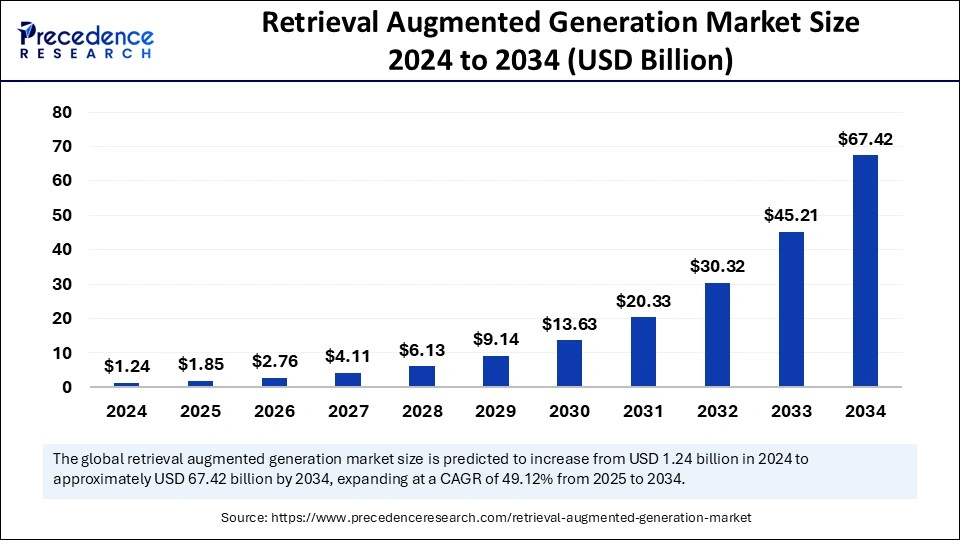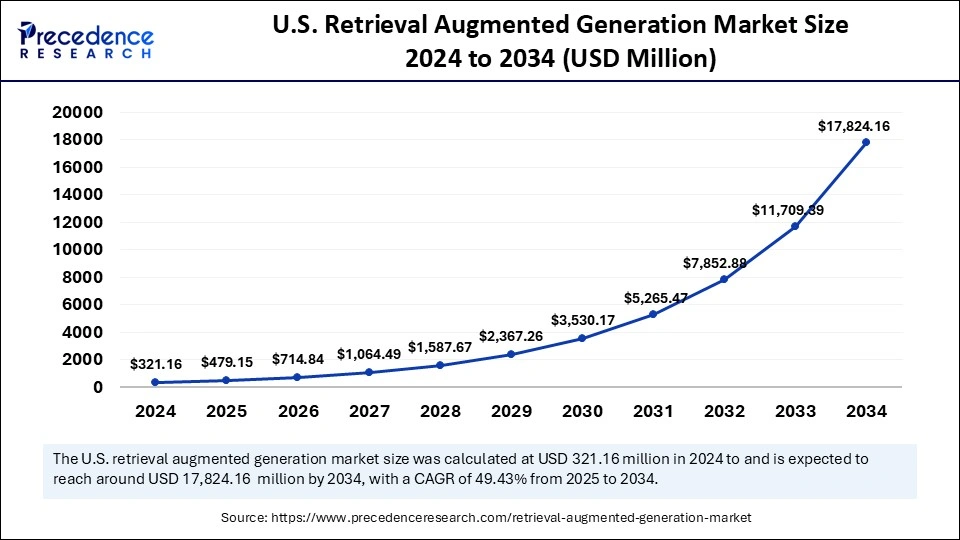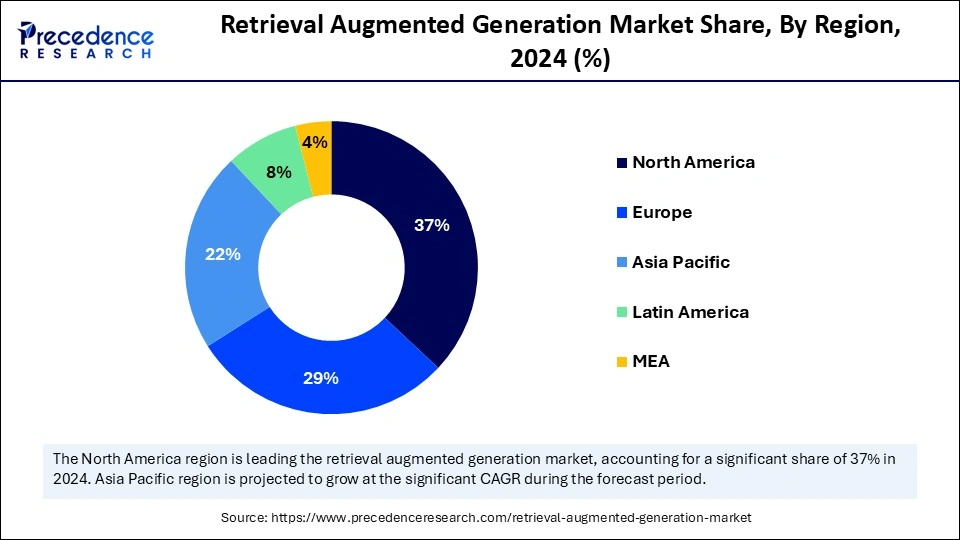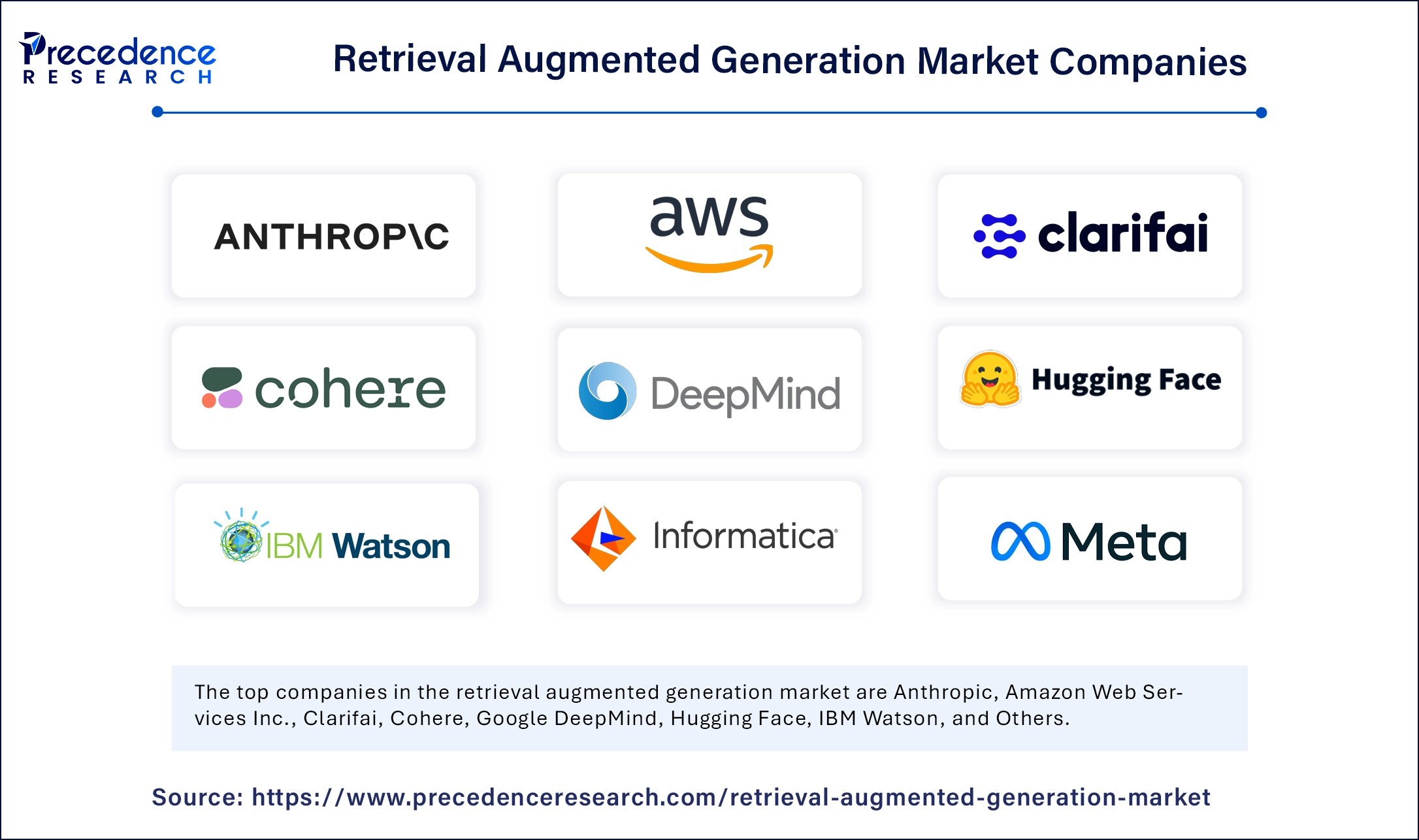March 2025
The global retrieval augmented generation market size is calculated at USD 1.85 billion in 2025 and is forecasted to reach around USD 67.42 billion by 2034, accelerating at a CAGR of 49.12% from 2025 to 2034. The North America market size surpassed USD 458.8 million in 2024 and is expanding at a CAGR of 49.32% during the forecast period. The market sizing and forecasts are revenue-based (USD Million/Billion), with 2024 as the base year.
The global retrieval augmented generation market size accounted for USD 1.24 billion in 2024 and is predicted to increase from USD 1.85 billion in 2025 to approximately USD 67.42 billion by 2034, expanding at a CAGR of 49.12% from 2025 to 2034. Growing due to increasing demand for more accurate, context-aware, and scalable AI-driven solutions across industries.

The integration of advanced technologies is reshaping the landscape of retrieval augmented generation market by enabling systems to deliver more relevant, timely, and context-rich insights. Modern RAG frameworks now include dynamic information from external sources in addition to static datasets, improving operational efficiency and decision-making across industries. Accuracy and real-time data access are crucial in industries like healthcare finance and enterprise solutions, where this evolution is especially beneficial. Additionally, advancements in machine learning are facilitating better comprehension and the smooth integration of generated output with retrieved content. In the digital age, RAG is becoming a crucial enabler of intelligent automation, customer engagement, and knowledge management as businesses place a higher priority on scalable intelligent solutions.
The U.S. retrieval augmented generation market size was exhibited at USD 321.16 million in 2024 and is projected to be worth around USD 17,824.16 million by 2034, growing at a CAGR of 49.43% from 2025 to 2034.

North America dominated the retrieval augmented generation market with the largest share in 2024. supported by a robust cloud infrastructure, a developed digital ecosystem, and the early adoption of cutting edge. Artificial Intelligence technologies across sectors. Both a steady stream of venture capital into generative AI startups and a high concentration of AI-focused businesses are advantageous to the area. RAG is being widely implemented by well-known tech companies, and it is still setting the standard for innovation and commercialization.
Asia Pacific is expected to grow at the fastest CAGR in the retrieval augmented generation market during the forecast period, fueled by an increase in enterprise AI adoption, a boom in digital transformation projects, and rising investments in regional AI solutions. Companies are utilizing RAG to support language-specific applications, automate workflows that involve a lot of documents, and improve customer engagement. Development in the area is also being accelerated by growing support from the public and private sectors. Growth is being driven by increased demand for AI-driven personalization in industries like retail education and governance, as well as by rapid urbanization and an expanding digital economy. RAG's versatility in retrieving domain-specific knowledge and adapting to local dialects makes it particularly useful in this multilingual and diverse area.

The European retrieval augmented generation market is observed to grow at a considerable rate because it emphasizes the responsible adoption of AI and has robust regulatory frameworks. RAG is being used by organizations for enterprise knowledge management, multilingual communication, and legal compliance applications. The region is a major influence on the development of standardized RAG implementations because of its emphasis on the ethical deployment of AI and secure data handling. Collaborations between governmental organizations, academic institutions, and private businesses that place a high priority on explainable AI and privacy by design architectures frequently spur innovation. RAG is now very relevant for industries like legal tech banking and public administration that demand accuracy, compliance, and transparency, thanks to this strategy.
The retrieval augmented generation market is experiencing significant momentum as businesses increasingly seek intelligent solutions that combine the generative power of language models with real-time information retrieval. For sectors like healthcare, finance, law, and customer service, this method is extremely valuable since it overcomes the drawbacks of static AI outputs by providing more precise, current, and context-aware responses. Growth in RAG technology is being driven by the increasing need for scalable, explainable, and personalized AI systems. Adopting is being fueled by both established tech companies and startups, but cloud-based deployments are still common because of their adaptability and simplicity of integration across business environments.
| Report Coverage | Details |
| Market Size by 2034 | USD 67.42 Billion |
| Market Size in 2025 | USD 1.85 Billion |
| Market Size in 2024 | USD 1.24 Billion |
| Market Growth Rate from 2025 to 2034 | CAGR of 49.12% |
| Dominated Region | North America |
| Fastest Growing Market | Asia Pacific |
| Base Year | 2024 |
| Forecast Period | 2025 to 2034 |
| Segments Covered | Function, Application, End User, Deployment, and Regions |
| Regions Covered | North America, Europe, Asia-Pacific, Latin America and Middle East & Africa |
Shift towards hybrid advanced architectural
The retrieval augmented generation market is gaining traction for their ability to blend generative power with verified retrieval, making them ideal for applications demanding accuracy and depth. When businesses are navigating digital transformation, hybrid models provide a well-rounded strategy that lowers risk and boosts user confidence. This is especially useful for factual consistency in customer-facing bots' enterprise search and research. Businesses are modernizing their knowledge access and utilizing it by incorporating RAG.
Emphasis on explainability and compliance
With increasing scrutiny from regulators, explainability is no longer optional; it's essential. Citing the documents used to generate responses is one way that RAG improves auditability. This promotes adherence to the law, increases user trust, and facilitates team training on AI-enabled processes. RAG is viewed by businesses looking to adopt. AI transparently as a competitive advantage.
Implementation complexity and technical barriers
RAG systems require intricate integration between retrievers, language models, and vector stores, demanding deep expertise in AI/Machine Learning pipelines. When orchestrating multi-component systems, organizations frequently encounter difficulties because minor configuration errors can compromise the quality of the output. Additionally, without specialized infrastructure and engineering support, optimizing vector similarity search and synchronizing retrieval with model latency because challenging. This lack of readiness slows the time to value for new AI businesses. Adapting RAG to current systems such as ERPs or knowledge portals can take months, even for tech-forward businesses. Outside of established AI teams, this complexity restricts adoption and deters experimentation.
High infrastructure and operational costs
Building and scaling RAG infrastructure is resource intensive, requiring powerful GPUs for embedding generation, high throughput vector databases, and low latency backends. Particularly for real-time search and conversational interfaces, cloud costs rise quickly as document volumes rise. To maintain relevance, businesses also need to make investments in monitoring systems, frequent updates, team training, and model refinement. These expenses are unaffordable for startups or those without sizable AI budgets. Leadership frequently deprioritizes RAG in favor of more straightforward AI solutions due to the total cost of ownership, which includes vendor tool maintenance and compliance.
Redefining enterprise search through contextual intelligence
RAG is redefining enterprise search by moving from keyword-based queries to context-aware, conversational interactions. Employees and decision-makers can receive dynamic situation-specific responses supported by trustworthy internal content rather than having to sift through static documents or frequently asked questions. This contextual knowledge facilitates more intelligent decision-making processes in addition to increasing search accuracy. Traditional search engines are unable to keep up with the growing volumes of documents in organizations. RAG bridges this gap by revealing hidden insights in a matter of seconds. RAG-based copilots are currently being investigated by enterprise SaaS providers to support knowledge-intensive tasks like compliance checks, strategic planning, and market research. The transition from passive document storage to active knowledge delivery is significant.
Transforming learning, onboarding, and HR knowledge portals
Enterprise is beginning to leverage the retrieval augmented generation market for internal onboarding, training, and HR self-service. Employees can now ask questions in their natural language and get accurate answers supported by validated policies and manuals, eliminating the need to search through lengthy documents or antiquated portals. This improves the overall employee experience, lessens reliance on HR teams, and expedites integration for new hires. To enable interactive learning where trainees can discuss and explore content, LandD teams are integrating RAG into internal LMS platforms. Businesses with remote or dispersed workforces gain the most from these AI-powered dynamic internal support systems.
The document retrieval segment dominated the retrieval augmented generation market in 2024. mainly because enterprise-grade search systems that can retrieve precise contextual information from large document repositories are in high demand. In sectors like legal healthcare and financial services, where decision-makers depend on instant access to reports, policy documents, and regulatory data, this segment has seen broad adoption. Contextual Q&A capabilities are taking the place of traditional keyword searches in organizations' knowledge bases and CRM systems by incorporating RAG-driven retrieval layers. The increasing reliance on document-based outputs is fueling steady vendor innovations and investments in this field.
The recommendation engine segment is expected to witness significant growth during the predicted timeframe by combining contextual content retrieval with user behavior data. RAG-based models are being used by retailers, OTT platforms, and EdTech companies to deliver real-time hyper-personalized recommendations. This offers recommendations that are explainable and dialogue-based, going beyond traditional collaborative filtering. Before making recommendations, the ability to obtain pertinent product descriptions, reviews, or educational materials greatly increases user engagement and trust. This market is predicted to grow at an exponential rate over the coming years due to the growing emphasis on conversational commerce and intelligent content delivery.
In 2024, the content-generation segment dominated the global retrieval augmented generation market. driven by the expanding demand across industries for scalable, pertinent, and accurate content. To create long-form content reports, product descriptions, and SEO-rich articles based on validated data sources, media marketing and publishing companies are incorporating RAG models. Because of its ability to reduce hallucinations and increase credibility, RAG is a better option than generic language models. Businesses are also using this segment for internal documentation policy drafting and training manuals, extending their application beyond communication with the outside world.
The customer support and chatbots segment is expected to grow at the fastest rate over the forecast period. Businesses in the e-commerce banking, healthcare, and telecom sectors are implementing virtual assistants driven by RAG. RAG-enabled systems, as opposed to conventional AI chatbots, obtain up-to-date information from business databases or frequently asked questions before producing responses, greatly enhancing user satisfaction and first-contact resolution. Thanks to developments in conversational AI and real-time document retrieval, this market is expected to expand quickly as companies look to provide 24/7 assistance with fewer human agents.
The retail and e-commerce segment dominated the retrieval augmented generation market in 2024. Because it places a strong emphasis on content automation and customized customer experiences, in this industry, companies are using RAG to improve product recommendations, create dynamic product descriptions, and power intelligent search engines that pull pertinent data from enormous catalogs. Conversion rates and customer satisfaction are increasing for retailers who base their generative responses on real-time pricing inventory and user behavior data. Companies like Shopify and Amazon are already utilizing RAG frameworks to optimize email marketing, merchandising copy, and chatbot support, putting the industry at the forefront of adoption.
The healthcare segment is expected to grow at the fastest rate in the studied years. To support medical research, compile patient records, and respond to clinical inquiries with well-founded data from vetted sources such as research papers or electronic health records, hospitals, pharmaceutical companies, and health-tech platforms are implementing RAG. By providing evidence-based results, RAG models help lower diagnostic errors. They are also being utilized more and more to create prescriptions, discharge summaries, and telehealth communications. To enhance clinical and operational results, the healthcare industry is quickly increasing its use of RAG due to rising investments in health AI and strict accuracy requirements.
The cloud segment held the largest retrieval augmented generation market share in 2024, mainly because of its affordability, adaptability, and scalability. Cloud deployment is preferred by businesses because it speeds up AI adoption without requiring infrastructure management. Companies can more easily test, implement, and scale solutions globally with the help of integrated RAG toolkits, vector databases, and APIs provided by major cloud providers like AWS, Google Cloud, and Azure. The go-to option for startups, agile teams, and content-driven industries, cloud-based RAG platforms also offer real-time updates, smooth collaboration, and simpler integration with other SaaS apps.
The on-premises segment is expected to grow at the fastest rate in the coming years, especially in industries with strict regulations like banking, healthcare, government, and defense. On-premises RAG solutions are the recommended option for organizations in these sectors that place a high priority on data privacy, security, and compliance. Eliminating exposure to third-party cloud environments and custom RAG setups hosted on local servers provides more control over data handling and model fine-tuning. Demand for on-premises deployment is noticeably increasing as companies grow more concerned about data sovereignty and intellectual property protection.

By Function
By Application
By End User
By Deployment
By Regional
For inquiries regarding discounts, bulk purchases, or customization requests, please contact us at sales@precedenceresearch.com
No cookie-cutter, only authentic analysis – take the 1st step to become a Precedence Research client
March 2025
November 2024
January 2025
November 2024